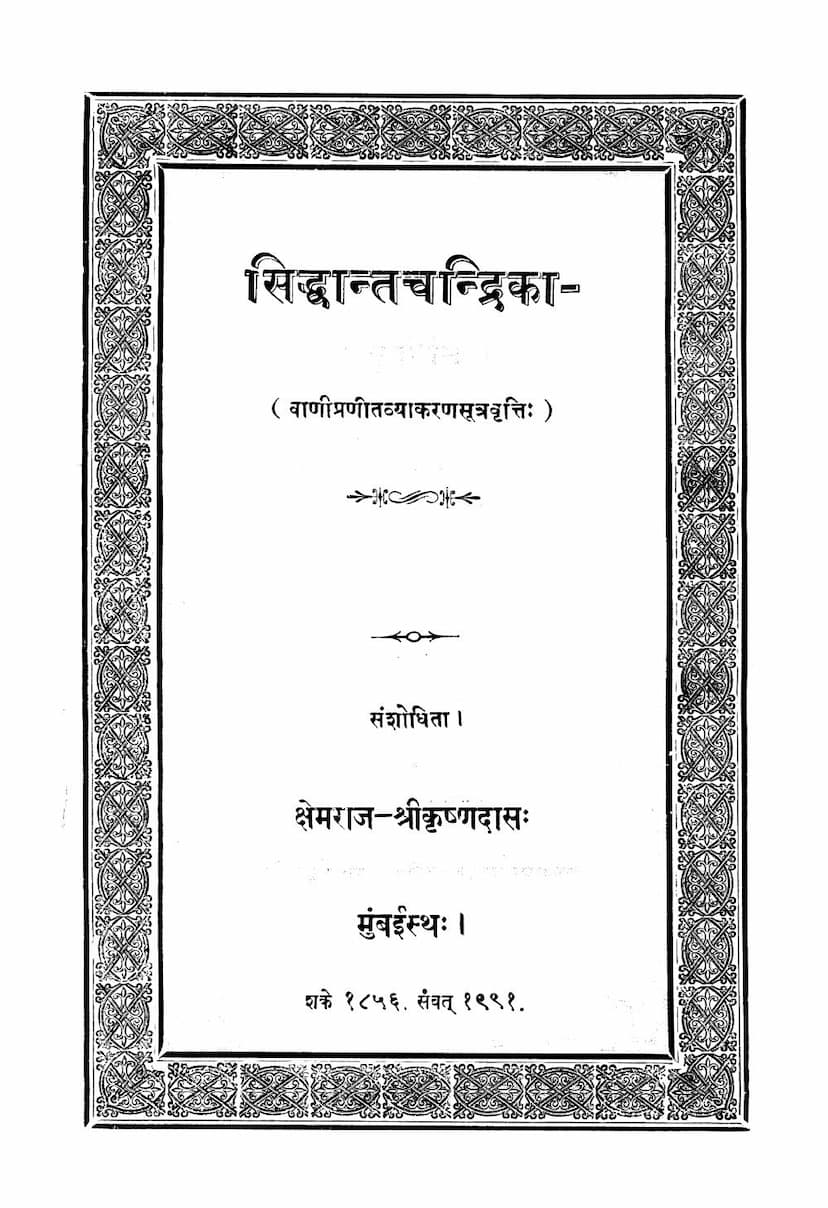Siddhant Chandrika Purvarddham
Added to library: September 2, 2025

Summary
Here's a comprehensive summary of the provided Jain text, "Siddhant Chandrika Purvarddham" by Ramsharma Pandit, based on the text you provided:
Book Title: Siddhant Chandrika Purvarddham (सिद्धान्तचन्द्रिका पूर्वार्धम्) Author: Ramsharma Pandit (रामशर्मा पण्डित) Publisher: Kshemraj Krishnadas (क्षेमराज श्रीकृष्णदास)
Overall Nature of the Work: This text is identified as the first part (Purvarddham - पूर्वार्धम्) of the "Siddhant Chandrika" (सिद्धान्तचन्द्रिका). It is a grammatical treatise on the Sanskrit language, specifically focused on the principles of grammar as applied within the context of Jain philosophy and teachings. The title itself, "Siddhant Chandrika," implies a "Moonlight of Principles" or a guiding light on fundamental doctrines, suggesting its aim is to elucidate grammatical rules in a clear and illuminating manner. The text includes commentaries ("Subodhini" - सुबोधिनी and "Tattvadipika" - तत्त्वदीपिका), indicating its depth and the effort made to explain complex grammatical concepts.
Key Sections and Content:
The table of contents (Page 3) reveals the comprehensive nature of this grammatical work. The "Purvarddham" (first part) covers a wide range of grammatical topics:
- Mangalacharan (मङ्गलाचरणम्): Invocation and auspicious beginnings, a common practice in ancient Indian texts.
- Sanjna Prakaran (संज्ञाप्रकरणम्): This section deals with grammatical terminology and definitions of key terms (e.g., vowels, consonants, specific phonetic categories, designation of parts of speech). The text goes into detail about the nature of vowels (अ, इ, उ, ऋ, ऌ), diphthongs (ए, ऐ, ओ, औ), their classification as sounds, and various Sanskrit grammatical terms like 'sandhi', 'gati', 'upadha', 'it-samjna', 'lop', 'luk', 'guṇa', 'vriddhi', 'svarāntapul'lingāḥ', 'hasāntapul'lingāḥ', etc.
- Paribhasha Prakaran (परिभाषाप्रकरणम्): This section focuses on the interpretive rules and principles of Sanskrit grammar that guide the understanding and application of other sutras (rules). It clarifies how rules should be understood in different contexts.
- Sandhi (Conjunction of Vowels and Consonants):
- Swar Sandhi (स्वर संधिः): Rules for the combination of vowels.
- Prakritibhavah (प्रकृतिभावः): The phenomenon where vowels remain unchanged, not combining.
- Hasa Sandhi (हससंधिः): Rules concerning certain consonants (h, y, v, l).
- Visarga Sandhi (विसर्गसंधिः): Rules for the combination involving the visarga (visarga) sound.
- Declension of Nouns (Nouns ending in Vowels):
- Svarant Pullingah (स्वरान्त पुंल्लिङ्गाः): Nouns ending in vowels, masculine gender.
- Svarant Strilingah (स्वरान्त स्त्रीलिङ्गाः): Nouns ending in vowels, feminine gender.
- Svarant Napunsaklingah (स्वरान्तनपुंसकलिंगाः): Nouns ending in vowels, neuter gender.
- Declension of Nouns (Nouns ending in Consonants):
- Hasant Pullingah (हसान्त पुंल्लिङ्गाः): Nouns ending in consonants, masculine gender.
- Hasant Strilingah (हसान्त स्त्रीलिङ्गाः): Nouns ending in consonants, feminine gender.
- Hasant Napunsaklingah (हसान्तनपुंसकलिङ्गाः): Nouns ending in consonants, neuter gender.
- Yushmad-Asmad Prakriya (युष्मदस्मत्प्रक्रिया): The declension of pronouns like 'you' (yushmad) and 'I' (asmad).
- Avyayani (अव्ययानि): Indeclinables or adverbs – words that do not change form.
- Stree Pratyayah (स्त्रीप्रत्ययाः): Feminine suffixes.
- Vibhaktyarthah (विभक्त्यर्थाः): The meanings and usages of grammatical cases (vibhakti).
- Samas Prakaran (समासप्रकरणम्): Rules of word-compounding (compounds).
- Taddhit Prakaran (तद्धितप्रकरणम्): Rules for derivative suffixes added to bases.
- Dvirukt Prakaran (द्विरुक्तप्रकरणम्): Rules for reduplication and repetition of words.
Commentaries: The text explicitly mentions two commentaries:
- Subodhini (सुबोधिनी): Meaning "easy to understand," this commentary aims for clarity.
- Tattvadipika (तत्त्वदीपिका): Meaning "lamp of reality" or "essence of truth," this commentary likely delves into deeper philosophical or practical aspects of the grammar.
Key Grammatical Concepts Discussed (as seen in the detailed index and sampled content):
- Sandhi: The rules of euphonic combination of sounds are extensively covered, including vowel combinations (स्वर संधि), consonant combinations (हस संधि), and visarga sandhi.
- Prakriti Bhava: The concept of maintaining the original form without sandhi is discussed.
- Noun Declension: A significant portion is dedicated to the detailed declension of nouns based on their endings (vowels and consonants), gender (masculine, feminine, neuter), and case (vibhakti). This includes specific rules for various stem types like 'a'-ending, 'i'-ending, 'u'-ending, 'ṛ'-ending, 'l'-ending, and consonant-ending stems.
- Pronouns: The declension of personal pronouns (yushmad, asmad) and demonstrative pronouns (idam, etad, tad, yushmad, asmad) is detailed.
- Indeclinables (Avyayāni): A substantial list of indeclinable words and their meanings/usages is provided.
- Feminine Suffixes (Stree Pratyayaḥ): Rules for forming feminine nouns from masculine bases are explained.
- Samāsa (Compounding): The rules for combining words into compound words are a major focus, covering various types like Avyayībhāva, Tatpuruṣa, Dvandva, Dviveda, and Bahuvrīhi samāsa. The text explains principles like prior placement (pūrvanipāta), rules for specific case combinations, and conditions for compound formation.
- Taddhita: Rules for adding derivative suffixes to form new words, indicating relationships, qualities, or origins, are meticulously outlined. This includes suffixes like 'aṇ', 'iñ', 'ṇya', 'ya', 'matup', 'tva', 'tal', 'k', 'ñi', etc., and their application based on context, gender, and meaning.
- Visarga Sandhi: Rules governing changes to the visarga sound are elaborated.
Target Audience and Purpose: Given the depth and detail, the "Siddhant Chandrika" is likely intended for serious students of Sanskrit grammar, particularly those interested in the traditional grammatical systems and their application within Jain scholarly traditions. The commentaries aim to make these principles accessible. The extensive coverage suggests it's a foundational text for understanding Sanskrit grammar in its full scope as understood by the author and the Jain tradition.
Overall Significance: The "Siddhant Chandrika Purvarddham" is a valuable contribution to the study of Sanskrit grammar, offering a detailed and systematic exposition of its rules. Its Jain context implies a potential focus on grammatical applications relevant to Jain literature and philosophy, though the core subject remains Sanskrit grammar as understood through traditional Indian linguistic scholarship. The inclusion of commentaries enhances its pedagogical value. The catalog link suggests its presence in academic or religious libraries, highlighting its scholarly or canonical importance.